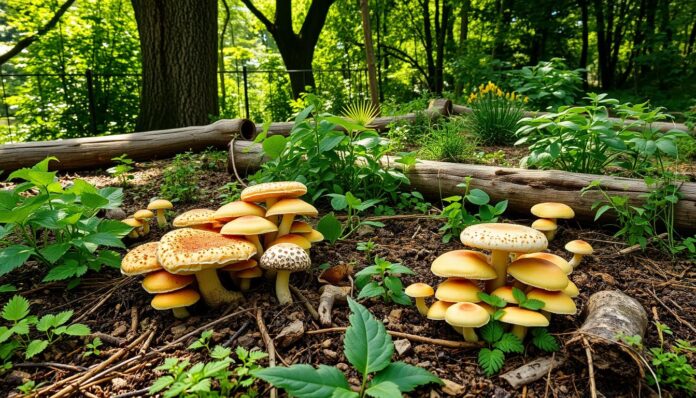Imagine a food system that’s both sustainable and boosts ecosystem health. Permaculture mushroom cultivation is a promising approach. It combines permaculture’s principles with mushroom farming’s benefits. We’ll see how mushrooms can make ecosystems more diverse, resilient, and productive.
Permaculture mushroom cultivation is a new way to grow food. It uses mushrooms to create closed-loop systems that reduce waste and increase productivity. With the right skills, anyone can start growing mushrooms. This helps make our food system more sustainable.
Key Takeaways
- Permaculture mushroom cultivation combines permaculture principles with mushroom farming for a sustainable food system.
- Mushrooms can enhance ecosystem health and diversity in permaculture systems.
- Sustainable mushroom farming can provide a profitable and environmentally friendly way to produce food.
- Permaculture mushroom cultivation can be adapted to various environments and climates.
- With the right techniques and knowledge, anyone can start cultivating mushrooms and contributing to a more sustainable food system.
- Permaculture mushroom cultivation and sustainable mushroom farming can help create a more resilient and productive ecosystem.
Understanding Permaculture Principles
Permaculture is all about making our environment sustainable by working with nature. It uses permaculture principles to build systems that are better for our planet. The word “permaculture” comes from “permanent” and “agriculture.”
At its heart, permaculture follows three main ethics: caring for the earth, looking out for people, and sharing fairly. These ideas can be applied to growing mushrooms. This way, we can make systems that are not only sustainable but also help our planet.
Definition of Permaculture
Permaculture is split into six zones, each needing less time and energy as you move further out. This method helps us use resources wisely and build a lasting ecosystem.
Key Principles of Permaculture
Important permaculture principles include reducing waste, using every available space, and harnessing natural energy. These ideas can be applied to permaculture mushrooms to make our systems more sustainable.
Benefits of Integrating Mushrooms
Adding permaculture mushrooms to our systems brings many advantages. They improve soil health, increase biodiversity, and offer a green food source. By using permaculture principles in mushroom farming, we can build a better, more sustainable world.
The Role of Mushrooms in Ecosystems
Mushrooms are crucial for keeping ecosystems in balance. They help break down organic matter and improve soil health. They even clean pollutants from the environment. This is key for the health of ecosystems and supports other organisms’ growth.
In permaculture, permaculture mushroom growing techniques are used to grow mushrooms. This helps us understand their value in ecosystems. It helps us create a more sustainable and balanced environment.
Nutrient Cycling
Mushrooms are important in nutrient cycling. They break down organic matter and release nutrients back into the soil. This keeps soil fertile and supports other organisms’ growth.
Soil Health Enhancement
Mushrooms also improve soil health. They break down organic matter and release nutrients. This makes the soil more balanced and fertile.
Mycoremediation Potential
Some mushrooms can clean pollutants from the environment. This is a big help in fighting pollution. It makes ecosystems more sustainable and balanced.
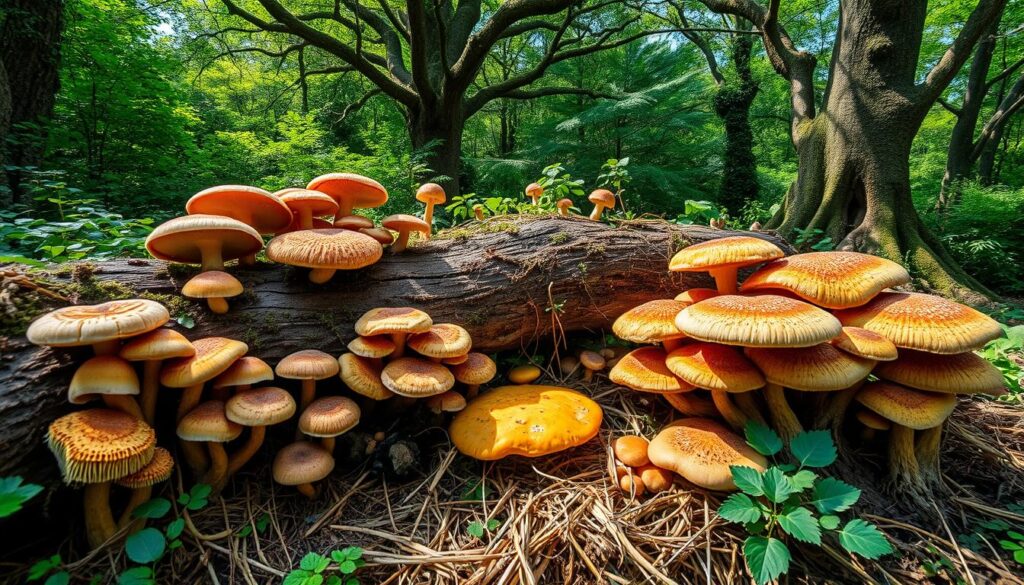
| Mushroom Species | Role in Ecosystem |
|---|---|
| Oyster Mushrooms | Nutrient cycling and soil health enhancement |
| King Stropharia | Mycoremediation potential and soil health enhancement |
Understanding mushrooms’ role in ecosystems is key. Using mycelium cultivation practices and permaculture mushroom growing techniques helps. We can make environments more sustainable and balanced. Mushroom-based systems help with nutrient cycling, soil health, and cleaning pollutants.
Choosing the Right Mushroom Species
Choosing the right mushroom species is key for a good harvest in permaculture. There are many mushrooms to pick from. It’s important to think about what you want to use them for, the local weather, and what they like to grow in.
Oyster mushrooms are easy to grow and can do well in many places. This makes them a favorite for growing mushrooms organically.
Mushrooms are important in permaculture for keeping the ecosystem balanced. Picking the right species helps make mushroom growing systems better and more stable. Some mushrooms, like shiitake, are great for people who already like them. Others, like oyster mushrooms, are perfect for beginners. The weather in your area also affects which mushrooms will grow best.
Here are some things to think about when picking a mushroom species:
- Edible vs. medicinal mushrooms: Pick a species that fits your needs.
- Local climate considerations: Choose a species that likes your local weather.
- Growth conditions and preferences: Pick a species that grows well in what you have available.
By thinking about these things and picking the right mushroom species, we can make permaculture systems that are full of life and balance. Whether you want to grow mushrooms for food or for health, picking the right species is the first step to success.
| Mushroom Species | Edible/Medicinal | Local Climate Considerations | Growth Conditions and Preferences |
|---|---|---|---|
| Oyster Mushrooms | Edible | Varied environments | Easy to grow, can thrive in a variety of substrates |
| Shiitake Mushrooms | Edible/Medicinal | Established consumer demand | Well-suited for logs or stumps, can tolerate a range of temperatures and humidity conditions |
Incorporating Mushrooms into Permaculture Design
Permaculture mushroom growing techniques aim to create a sustainable ecosystem. By adding mushrooms to permaculture, we boost biodiversity and help plants grow well. Mycelium, the mushroom’s root system, breaks down organic matter and recycles nutrients.
Layering in a Permaculture Garden
Layering is vital in permaculture, and it works for mushrooms too. It helps mycelium grow and boosts mushroom production. We use organic materials like straw and wood chips to make a nutrient-rich environment.
Creating Healthy Microclimates
Microclimates are key in permaculture for mushroom growth. We create shaded, moist areas for mycelium to thrive. Plants and organic materials help build these microclimates.
Companion Planting Strategies
Companion planting is essential in permaculture for mushrooms. It fosters a beneficial relationship between mushrooms and other plants. This reduces pests and diseases. Herbs and vegetables are good companions for mushrooms.
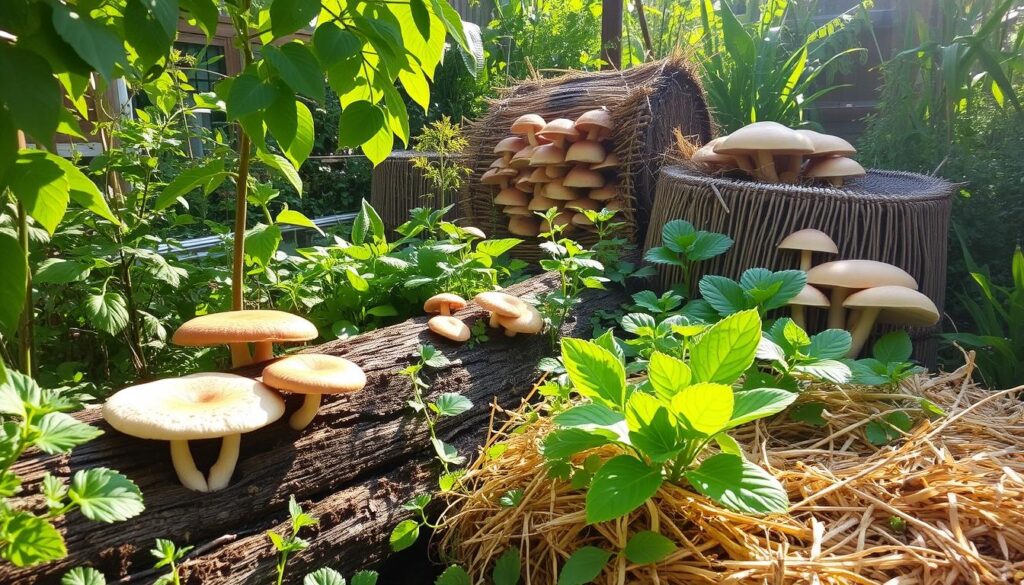
| Mushroom Species | Companion Plants |
|---|---|
| Shiitake | Herbs and vegetables |
| Oyster | Grasses and legumes |
Adding mushrooms to permaculture makes our ecosystems more diverse and sustainable. Techniques like permaculture mushroom growing and mycelium cultivation enhance plant health and biodiversity.
Cultivation Techniques for Beginners
Starting with permaculture mushroom cultivation is exciting. First, learn about preparing spawn and substrate, inoculation, and keeping conditions right. A good compost for mushrooms includes horse manure. The best temperature for starting mushrooms is about 23°C (73°F).
For inoculation, add spores to coffee grounds within 24 hours. This helps mycelium grow well. Home growers often choose button mushrooms, shiitake, and oyster mushrooms. They are easy to grow and nutritious, fitting well into a permaculture system.
Preparing Spawn and Substrate
To make spawn, get mushroom spores or plug spawn from a trusted supplier. Use pasteurized straw or coffee grounds as substrate. A 2-gallon bucket is best for growing mushrooms in coffee grounds, filled 2/3 full.
Inoculation Methods
Inoculation methods depend on the mushroom type and substrate. For log-based growing, use inoculated dowels. Cut and inoculate logs within 2-3 weeks. Logs should be 3 to 5 inches in diameter and about 4 feet long.
Maintaining Optimal Conditions
To keep conditions right, keep the substrate moist and ensure good airflow. Use beeswax to seal dowels in logs. Regularly check logs after rain for mycelium growth. By following these steps, beginners can grow mushrooms in their permaculture systems.
| Species | Substrate | Inoculation Method |
|---|---|---|
| Oyster | Coffee grounds | Plug spawn |
| Shiitake | Logs | Inoculated dowels |
Advanced Mushroom Cultivation Techniques
Experienced mushroom growers can boost their yields with advanced techniques. Truffle cultivation is one such method. It involves putting mycelium into tree roots. This requires careful conditions but can produce top-notch truffles.
Log vs. bag cultivation is another advanced technique. Log cultivation uses logs with mycelium, while bag cultivation fills bags with substrate. Each method has its pros and cons. The choice depends on the grower’s needs and goals. These practices help create stronger systems and increase yields.
Using indoor spaces is also an advanced technique. It allows for mushroom production all year, no matter the weather. Indoor setups can produce more, but they need more energy and cost more upfront. Here’s a comparison of indoor and outdoor cultivation:
| Cultivation Method | Advantages | Disadvantages |
|---|---|---|
| Indoor | Higher yields, year-round production | Higher energy inputs, initial investments |
| Outdoor | Lower startup costs, natural resources | Lower yields, seasonal constraints |
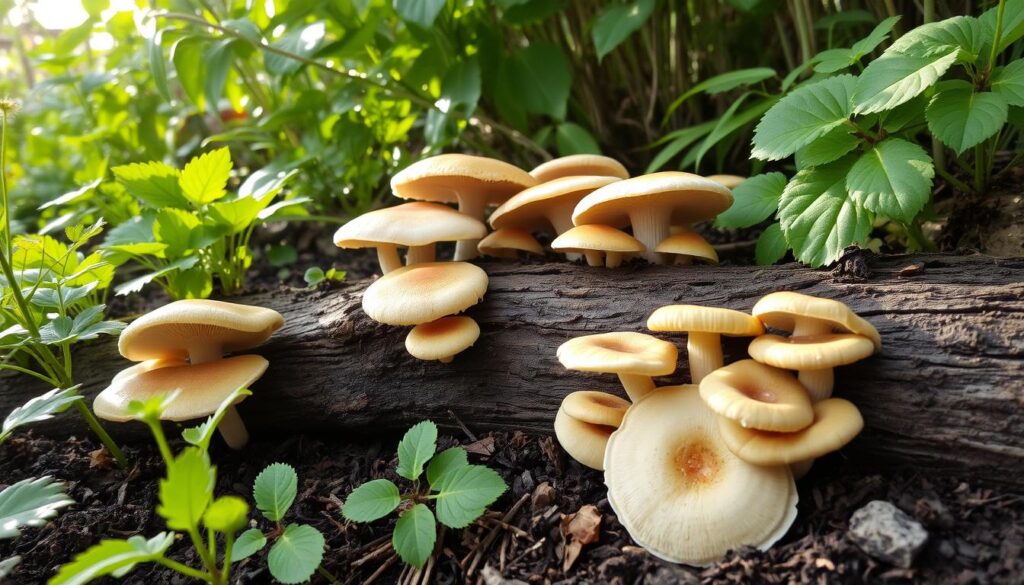
Pest and Disease Management
Managing pests and diseases is key to growing mushrooms in permaculture. Pests like fungus gnats, spider mites, and flies can harm mushrooms. They can also spread bacteria and viruses, ruining your crop. It’s important to use organic methods to keep your mushrooms healthy.
To keep pests away, control humidity, temperature, and air flow. Regular checks for pests are also crucial. This helps stop diseases from spreading.
Mushrooms can get sick from diseases like bacterial blotch, cobweb mold, and dry bubble disease. Organic ways to fight these include crop rotation, using barriers, and keeping things clean. These steps help your mushrooms grow strong and healthy.
Healthy crops also need good air, moisture, and nutrients. Use pasteurized substrates like corn stalks or wheat straw. Make a “tea” that feeds and protects your mushrooms. With these methods, growing mushrooms in permaculture can be rewarding and sustainable.
| Disease | Causes | Organic Control Methods |
|---|---|---|
| Bacterial Blotch | High humidity and low air circulation | Crop rotation, physical barriers, sanitation practices |
| Cobweb Mold | High humidity and low temperatures | Improving air circulation, reducing humidity, using organic fungicides |
| Dry Bubble Disease | Viral infection | Removing infected mushrooms, improving air circulation, using organic fungicides |
Harvesting and Post-Harvest Processing
Harvesting and post-harvest processing are key in permaculture mushroom growing. The time to harvest depends on the mushroom type. For example, oyster mushrooms grow fast and are ready in 6-10 days. Lion’s mane mushrooms are best when their spines are 0.25 inches long, about 4-7 days after they start to grow.
When you harvest, you can either cut or pull the mushrooms. Both methods work well without hurting future growth. Pulling tells the fungus to grow more. Cutting might leave stems open to infection. Most mushrooms can grow more than once after the first harvest.
To get the most from your mushrooms, it’s important to preserve them well. You can also make products like dried or powdered mushrooms. This makes your mushrooms last longer and can make more money.
Some important things to remember include:
- Harvest at the best time for flavor and texture
- Keep mushrooms fresh with the right handling and storage
- Make products like dried mushrooms to last longer and earn more
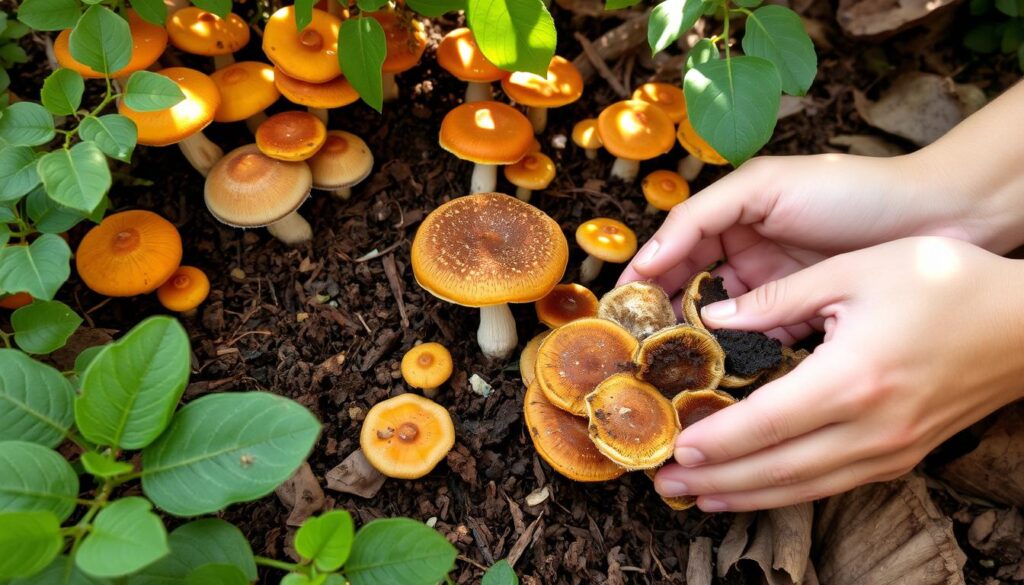
By following these tips and using permaculture and mycelium practices, you can make more and better mushrooms.
| Mushroom Species | Harvest Time | Handling and Storage |
|---|---|---|
| Oyster Mushrooms | 6-10 days after pinning | Store in a cool, dry place |
| Lion’s Mane Mushrooms | 4-7 days after pinning | Store in a sealed container |
Economic Benefits of Mushroom Cultivation
Mushroom cultivation can be a profitable venture, thanks to permaculture. Permaculture mushroom cultivation grows many mushroom species. Each has its own traits and market demand. This knowledge helps farmers make their farms more sustainable and profitable.
The value of different mushroom species varies. Truffle mushrooms, for example, are highly sought after for their flavor and aroma. This makes them a valuable crop for sustainable mushroom farming. Other species like oyster mushrooms and shiitake mushrooms are also in demand and can be grown on various substrates.
Community supported agriculture models are key to mushroom cultivation’s success. By working with local restaurants and consumers, farmers can ensure a steady market. This leads to a consistent income. Here are some economic benefits of mushroom cultivation:
| Mushroom Species | Market Demand | Profitability |
|---|---|---|
| Truffle Mushrooms | High | High |
| Oyster Mushrooms | Moderate | Moderate |
| Shiitake Mushrooms | High | High |
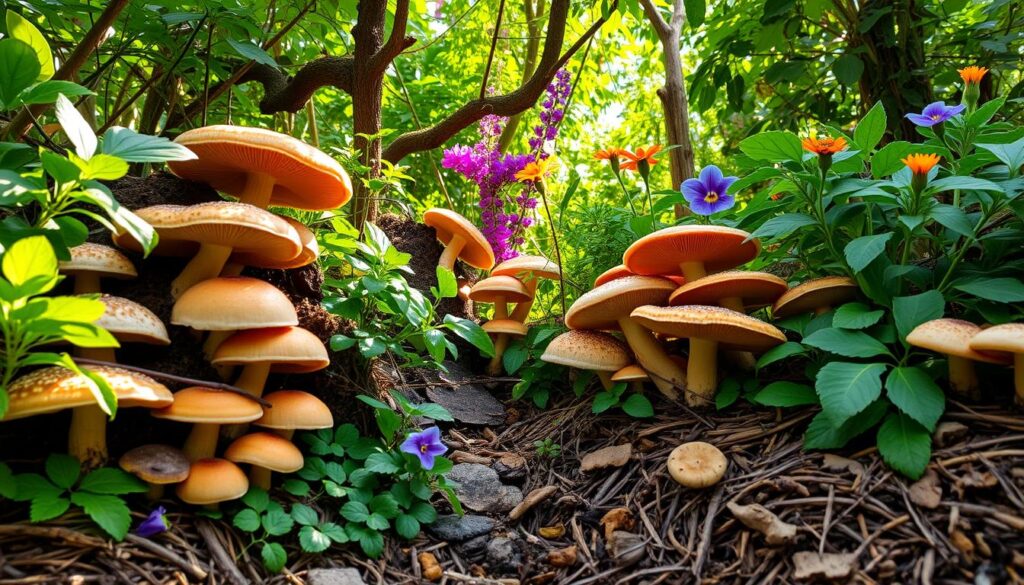
In conclusion, mushroom cultivation is a profitable and sustainable venture. It’s even better when done in permaculture systems. By understanding the economic benefits and using sustainable mushroom farming practices, farmers can run a successful and eco-friendly business.
Understanding the Life Cycle of Mushrooms
The life cycle of mushrooms is complex, with stages from spore germination to fruiting body formation. By knowing these stages, growers can create the best conditions for growing mushrooms. The cycle includes four main steps: spore, germ, hyphae, and mature mycelium.
Some mushrooms, like oyster mushrooms, grow fast and produce fruit in 3 to 4 weeks. Shiitake mushrooms take longer, fruiting in 6 to 12 months. This shows how crucial it is to understand mushroom growth and use good growing practices.
Fungal Growth Stages
The growth stages of fungi are:
- Spore phase: The start and end of a mushroom’s life, with millions of tiny spores released by mature mushrooms.
- Germ phase: The stage where the spore germinates and forms a hyphae.
- Hyphae phase: The stage where the hyphae grows and forms a mature mycelium.
- Mature mycelium phase: The stage where the mycelium produces fruiting bodies.
Environmental Triggers for Fruiting
Environmental factors like temperature, humidity, and light are key for fruiting. By managing these, growers can help their mushrooms produce fruit. Knowing the mushroom life cycle and using permaculture techniques can improve yields.
| Mushroom Species | Growth Rate | Fruiting Time |
|---|---|---|
| Oyster Mushrooms | Fast | 3-4 weeks |
| Shiitake Mushrooms | Medium | 6-12 months |
| Truffles | Slow | Over a decade |
Leveraging Technology in Mushroom Cultivation
Technology can really help in growing mushrooms. Apps and new farming methods make growing mushrooms more efficient. For example, vertical farming lets you grow more in less space, perfect for small areas.
Using technology in mushroom growing has many benefits. Here are a few:
- It makes it easier to know how much you’ll get by controlling the environment.
- It helps mushrooms grow better by keeping the air and conditions just right.
- It saves money and reduces mistakes by automating tasks and using sensors.
- It uses data to predict how much you’ll get and improve growing conditions.
Also, using permaculture with mushroom farming makes things more sustainable. This approach not only boosts production but also helps the environment. By using these technologies and methods, mushroom growing can become better for both people and the planet.
| Technology | Benefits |
|---|---|
| Vertical farming | Increased yield per square foot |
| Controlled environments | Improved predictability of yields |
| Automation and sensors | Reduced labor costs and human error |
The Future of Mushroom Cultivation in Permaculture
As we move towards more sustainable living, permaculture mushroom growing techniques are key. They help make permaculture systems more regenerative and sustainable. By using mycelium cultivation practices, we can improve soil health, water quality, and biodiversity.
There’s a growing interest in permaculture with a mycological twist. This mix of permaculture and mushroom cultivation aims for a holistic, sustainable farm. Some trends and opportunities include:
- More focus on soil health and biodiversity
- New mycelium cultivation practices for better efficiency and sustainability
- Higher demand for permaculture mushroom growing techniques in cities and countryside
As research and development grow, we’ll see new permaculture mushroom growing techniques. By embracing these trends, we can build a more sustainable food system for the future.
Educational Resources for Mushroom Cultivation
For those interested in growing mushrooms in a permaculture setting, many resources are available. Online courses and workshops introduce you to mushroom cultivation. They cover organic methods and permaculture principles. These are great for beginners, offering a strong base for more learning and trying out.
Online courses teach the basics of growing mushrooms, including permaculture and organic methods. They often include hands-on training. This lets you get real experience in growing mushrooms. Books and publications also offer detailed information on mushroom cultivation. They share valuable insights and tips for growers.
For a deeper dive into mushroom cultivation, there are many books and publications. They cover everything from the basics of permaculture to advanced organic techniques. Exploring these resources can help you understand mushroom cultivation better. This can improve your skills and knowledge in this interesting field.
Some popular educational resources for mushroom cultivation include:
- Online courses, such as those offered by reputable institutions or experienced cultivators
- Workshops and hands-on training sessions, providing practical experience in mushroom cultivation
- Books and publications, offering in-depth information on permaculture mushroom cultivation and organic mushroom cultivation techniques
Building a Community Around Mushroom Cultivation
Mushroom cultivation is becoming more popular. Building a community around it is key for sharing knowledge and best practices. By connecting with other growers, people can learn new techniques and improve their systems.
Organizing local workshops is a great way to build this community. Experienced growers can share their knowledge and teach hands-on. Topics like substrate preparation and pest management are covered. This helps growers network and work together.
Benefits of Community Building
Building a community around mushroom cultivation has many benefits. It allows for shared knowledge and resources. This improves growing practices and increases yields.
- Access to expert advice and guidance
- Opportunities for networking and collaboration
- Shared resources and knowledge
- Improved growing practices and increased yields
Community building also promotes sustainable practices. Growers can work together to create a healthier environment. This makes the community more vibrant and diverse.
Case Studies: Successful Permaculture Mushroom Farms
Permaculture mushroom farming is becoming more popular worldwide. The Mushroomery in Brunswick, Naarm (Melbourne), is a great example. It grows oyster mushrooms in a 10m² space and supplies two restaurants and a farm gate sometimes. This shows how small, sustainable farms can make a big impact.
Using sustainable methods is key in permaculture mushroom farming. The Mushroomery reuses buckets from local businesses. This cuts down on waste and supports a gift economy, where people exchange work for goods. The leftover straw from mushrooms is used as mulch, helping the soil and keeping it healthy.
| Statistic | Value |
|---|---|
| Growing space | 10m² |
| Maturation period for oyster mushrooms (winter) | 6-9 weeks |
| Maturation period for oyster mushrooms (summer) | 2-3 weeks |
| Plastic bags saved per week | 120 |
These examples show how permaculture mushroom farming can help our planet. It supports sustainable food systems, promotes green practices, and boosts local economies.
Conclusion: Embracing Mycology in Sustainable Practices
Integrating permaculture mushroom growing techniques and mycelium cultivation practices can change sustainable agriculture and land use. Mycology’s power lets us build better, more lasting systems. These systems help both people and the planet.
Encouraging Community Involvement
Mushroom cultivation in permaculture needs community help and sharing knowledge. New growers should look for local workshops and online resources. They should also talk to experienced mycologists to learn the best ways.
By working together, we can grow mycology and encourage more people to use mushrooms in their green living.
Future Steps for Aspiring Growers
For those starting their mushroom growing journey, the future is bright. Keep trying different species, substrates, and methods to see what works for you. Stay current with new research and ideas.
Think about getting certified or formal training to learn more. By diving into mycology, you open doors to a greener, more abundant future.

